
Introduction to the Gadla Lālibalā collection
The page discussed here (Fig. 1) comes from MS BP Parm. 3852, a manuscript now held in the Biblioteca Palatina in Parma, Italy. It is one of the twenty-five manuscripts of the Mordini collection,A catalogue of the collection is currently being compiled by Gianfrancesco Lusini. all of which are written in Geez, the classical Ethiopic language.The term 'Ethiopic' refers here to a broad cultural region that encompasses both Ethiopia and Eritrea. The library’s Geez manuscripts vary in age and provenance, and none show any similarity to MS BP Parm. 3852, either in terms of content or palaeography. This is the first detailed discussion of the manuscript.
One of the crucial issues for any scholar working with a Geez manuscript is how to define its contents. Modern editions condition their readers to look for titles, yet titles are not always present in Geez manuscripts containing original non-translated works, or, if present, they serve specific purposes determined by context. The Gadla Lālibalā collection, though, holds an ensemble of elements with the potential to help clarify this issue.
Contents of MS BP Parm. 3852
The manuscript was produced between AD 1939 and 1940 and contains a copy of a collection of sixteen texts—or rather textual units—related to Saint King Lālibalā, and is now generally known as the Gadla Lālibalā collection.I understand a ‘textual unit’ to be a well-defined, clearly delimited piece of text within a larger work (the ‘macro-text’). Such a unit should have clear indicators of internal coherence and unity as a piece of text, whether physical (e.g., a particular page layout, mise en texte, mise en livre), stylistic, linguistic, or thematic (content). It should be defined by a clear break from the preceding and following passages within the broader text, this typically (but not necessarily) being a physical blank space in the manuscript. A textual unit will also typically show evidence of independent circulation, such as the potential to exist separately from its macro-text by also appearing in other, different works, and potentially surrounded by other, different textual units. See Valieva (2019: 17). Depending on its content, a textual unit may or may not qualify as a distinct ‘work’. Lālibalā was a well-known king of the so-called Zāgʷe dynasty, which ruled Ethiopia in the twelfth and thirteenth centuries.
It can be difficult to capture the contents of some textual units in a brief description, and the working titles proposed here do not originate from the manuscript but rather aim to capture the dominant theme of the corresponding unit (Valieva 2019: 18–23). The manuscript begins with six textual units, each of which appear to be poetical compositions closely based on Scripture and celebrating Saint Lālibalā’s virtues:
- Preamble, ff. (folios) 1ra–6vb;Edited and translated by Jules Perruchon, see Perruchon (1892). Textual units 1, 2, and 8–14 all appear in this edition; units 3, 4, 5, and 6 do not.
- Jesus and His redeeming fire, ff. 6vb–9rb;
- Teachings about saints, ff. 9rb–13rb;
- Eulogy of Lālibalā as the one who entered the Heavenly Jerusalem, ff. 13rb–18rb;
- Eulogy of Lālibalā as the one who accomplished the Word of the Gospel, ff. 18rb–22rb;
- Praise for Lālibalā, ff. 22rb–33va.
Unlike the praise in units 1–6, the following units 7–16 contain narrative texts, which can be briefly summarized as follows:
- The seventh and largest textual unit, ff. 33vb–118vb begins the Life of Lālibalā proper.Textual unit 7, The Life of Lālibalā was partially edited in Perruchon (1892). Kur (1972 : 381–426) fills some (but not all) of the lacunae in Perruchon’s edition. It starts by describing the circumstances of his birth, though its central part relates Lālibalā’s ascent to the seventh heaven, where God reveals to him the sanctuaries that were later reproduced as the Lālibalā rock-hewn church complex. Having returned to earth, married, undergone a series of tribulations and undertaken a pilgrimage to Jerusalem, Lālibalā is then said to have become a king.
The page represented in Fig. 1 marks the concluding part of unit 7 and the beginning of the following unit 8. The dotted line in red and black ink marks the boundary between them. Textual units 8–16 are grouped by the scribe as ‘miracles’ in the manuscript:
- Three men visit King Lālibalā, ff. 118va (beginning toward the bottom of the page)–120rb.In some manuscripts, textual units 8–14 and 16 have their own titles (discussed below). The text, modelled after the story of Abraham, narrates that when King Lālibalā was about to eat, three brothers came and begged him for food; these three brothers were later revealed to be angels.
- How a river swallowed Lālibalā’s honey and then spat it out, ff. 120rb–123ra. The text details a day of bringing tribute to King Lālibalā.
- How Lālibalā became a pauper, ff. 123ra–124vb. This fragment depicts how he left a feast with his soldiers and dined with beggars who had received the bread of poverty distributed by Lālibalā’s own command.
- Lālibalā and a rebel, ff. 124vb–127ra. The text records a story about a revolt against the king.
- How a prayer to Lālibalā saved a rich woman, f. 127ra–va. A story of a self-indulgent rich woman who ate human flesh and was about to die as God's punishment, but was saved when she turned to Lālibalā in prayer.
- How a man defamed Lālibalā and was punished by becoming blind, ff. 127va–128va.
- The virtuous deeds of Lālibalā, ff. 128va–135va. This text narrates how King Lālibalā built churches modelled after the heavenly sanctuaries and then asked God to restore ‘the House of Israel’, interpreted as referring to the so-called Solomonic dynasty.
- The discovery of a text in a place called Beta Māryām, ff. 135va–136rb.Edited and translated in Derat (2016). This short, self-referential section presumably provides an origin story for the book containing the Gadla Lālibalā collection.
- Gabra Manfas Qəddus and Lālibalā ‘A’, ff. 136rb–137va.The collection of ‘Miracles in life’ of Gabra Manfas Qəddus, edited by Paolo Marrassini, records the same miracle. However, this text is closer to what Marrassini called a ‘shorter redaction, coming from a unique archetype’ provided in the apparatus of the printed edition with the siglum ‘A’. See Marrassini (2003). This text recounts a story about Gabra Manfas Qəddus and Lālibalā when they lived as hermits.
Historical background of the Life of Lālibalā and its dating
The core text of the collection, the Life of Lālibalā / ገድለ ላሊበላ / Gadla Lālibalā (gadl = ‘struggle’), is found in a number of manuscripts dating to the second half of the fourteenth century AD, though discrepancies between manuscripts suggest that the text had already been circulated for some time, and must have been composed somewhat earlier.To my knowledge, the Life of Lālibalā is found in 37 manuscripts. I have been able to examine 23 of these in Ethiopia, France, Italy, and the UK. The exact territory of the kingdom of Lālibalā is not known, but traces of his presence can be found in the highlands of present-day Eritrea and Ethiopia. Marie-Laure Derat has suggested that Roha-Lālibalā city is the extreme southern limit of the extension of King Lālibalā’s power (Derat 2018), which became his main lieu de mémoire and where he is still commemorated today as a saint. His ‘Life’ narrates that he was taken up to heaven and, on returning, constructed earthly replicas of the churches he saw there, which are identified with the renowned rock-hewn churches in the town of Roha-Lālibalā in Lasta.I adopt here the distinction introduced by Derat between Saint King Lālibalā as a personal name and Roha-Lālibalā as a toponym. After a change in the ruling dynasty around 1270, King Lālibalā came to be regarded as a usurper and this is what is presented in one of the texts in the collection, the story about the virtuous deeds of Lālibalā (unit 14). Many later kings disregarded, or perhaps carefully regarded, this dispute, sought Saint King Lālibalā’s patronage, commissioned copies of the Life of Lālibalā, and thus contributed to the spread of his fame and the literary dossier.
Features of the manuscript
MS BP Parma 3852 was imported to Italy under unknown circumstances from Eritrea, where it was likely produced, though knowledge of manuscript production in Eritrea is limited due to the turbulent recent history of the country. The manuscript will therefore be analysed as a sample of a broader ‘Geez manuscript culture’, which is understood mainly through manuscripts found in what is today Ethiopia. The codex was produced between 1939 and 1940, but it follows a tradition of Geez manuscripts that can be traced back to the fourth century AD, and which is still ongoing (Valieva 2020). The mise en texte of the page under review was probably developed at the end of the seventeenth or beginning of the eighteenth century, as it reflects the existence of a mature liturgical cult of King Lālibalā that apparently took shape at that time.
The book is 210mm high and 155mm wide; other manuscripts of the Gadla Lālibalā collection range from 355–275mm by 175–145mm. It has 137 folios (plus four flyleaves), each bearing writing on both the recto and the verso. As is typical for Ethiopic codices, it is bound between two wooden boards which in this case are covered with printed fabric in a floral design. (Often in Ethiopic manuscripts, the boards are covered with finely-tooled stamped leather.)
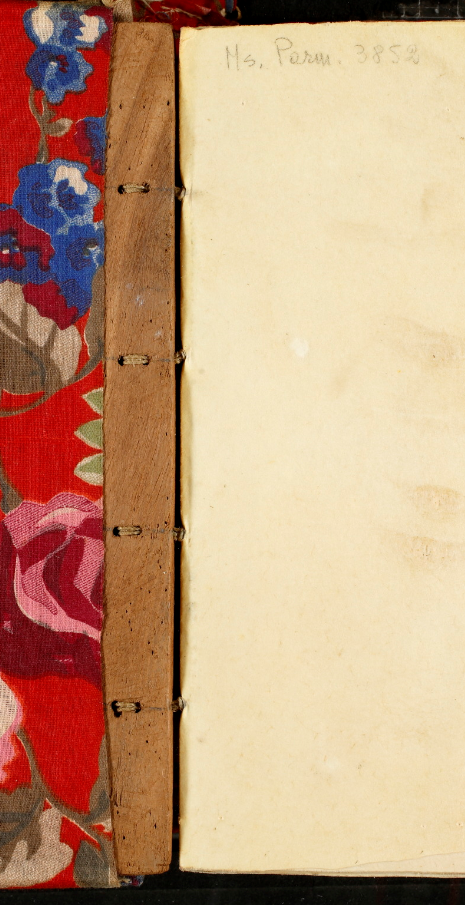
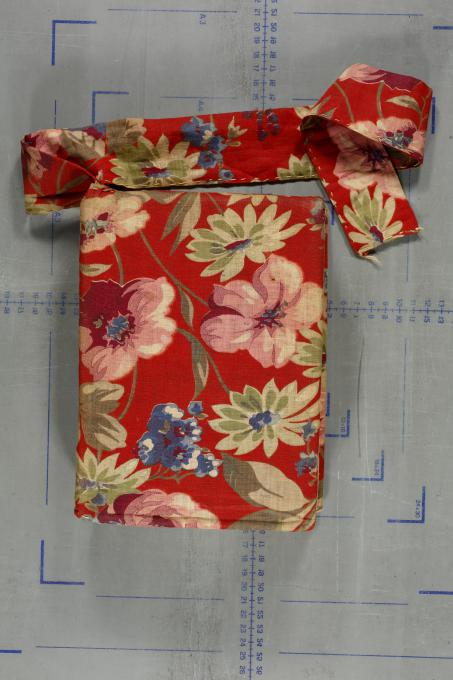
The book is kept in a two-part leather slip-case that was designed specifically for the purpose and which perfectly matches it in size.
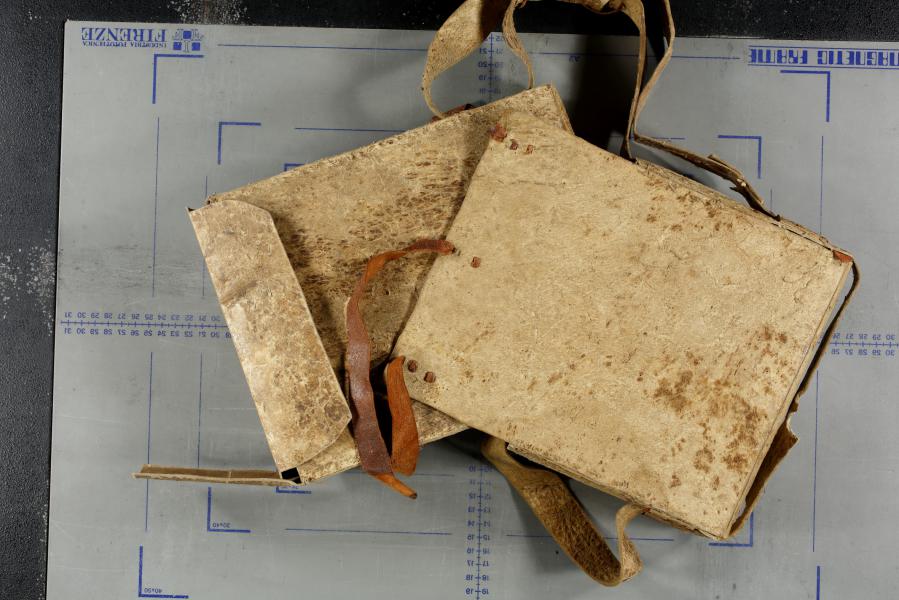
Writing support
The leaves of the book are made of parchment, likely prepared from goatskin. Paper was known by the mid-twentieth century in Ethiopia and Eritrea but was not widespread, whereas parchment remained (and remains) a common writing support, particularly for religious texts. Goats are common domestic animals in the Ethiopian and Eritrean highlands; their flesh is consumed, and their skin is used for, among other things, the manufacture of parchment.
Writing system
The writing is in fidal, the Ethiopic script. This was originally a purely consonantal writing system, but by the fourth century the script had developed into a syllabary: each of the consonants received six modifications (a system probably adopted from Indian syllabic scripts) corresponding to seven vowels, forming seven (6+1) orders. The syllabary has since been used, with minor changes and additions, to write classical Ethiopic (Geez), Amharic, Tigrinya, Tigre, Gurage, and at times other vernacular languages of Ethiopia and Eritrea. The script is read from left to right, and top to bottom. In MS BP Parm. 3852 the text is divided into two columns, a layout common for Ethiopic Christian texts meant to be read aloud in shrines.
Language
The language of writing is Geez, an ancient Ethiopian Semitic language documented since the third or fourth centuries AD that was the official language of the Kingdom of Aksum (first to seventh centuries). According to the predominant hypothesis, at some point, probably in the tenth or early eleventh centuries, Geez ceased to be a commonly spoken language, but remained a classical tongue used for scholarship, religious practice, record keeping, and literature.
Mise en texte
Word endings marked with two vertical dots (derived from vertical strokes) were common in the established tradition of written Geez, though in recent times this has been supplanted by the use of spaces. The scribe of this manuscript, a certain Walda Giyorgis, employed groups of dots to mark the beginnings and ends of textual units, paragraphs, sentences, and sub-clauses within sentences. Abbreviations are rare in hagiographic Geez texts, other than simple abbreviations of the formulaic expression ‘forever and ever’ and a few others. Thus, the last line of the left-hand column reads laʿālama ʿāla ʾa ‘forever and eve(r), a(men)’, where the final ‘-men’ of the word ‘amen’ is omitted.
Pricking and ruling
The layouts of this page’s recto and verso are identical, and the neatly aligned columns, margins, and lines were produced by pricking, a common technique in most Ethiopian manuscripts. Four round prick holes made with an awl are visible in the upper and lower margins of the folios. These pricks were used to draw the vertical lines marking the left and the right boundaries of each of the two text columns: two pricks for each column of text. In the outer margins, one can see prick-marks that serve to guide the horizontal ruling, although they are not clearly distinguishable in Fig. 1. The left prick is connected with the right prick, allowing a straight line to be drawn. These pricks were then used to draw the twenty-one horizontal lines at equal distances from one another. The vertical and horizontal scoring that joins the pricks was also done with an awl (Balicka-Witakowska, Bausi, et al. 2015: 160–162).
Workshops vs the individual work of a single scribe
It is difficult to say how many people were involved in the production of a book until the twentieth century, from which there are biographical accounts and some scribal reports. Professions such as scribe, illuminator, and parchment maker existed as separate occupations, but only the names of the commissioner and the scribe, and occasionally the painter, are commonly recorded in manuscripts. Scribes in the twentieth century increasingly mentioned only their own names, and this might be the case for MS BP Parm. 3852, although it cannot be known with certainty whether the parchment and illustrations made by the same individual who wrote the text. Walda Giyorgis nonetheless seems to have been a professional, as his writing is accurate and consistent.
Inks
The main body of the text is written in a black, presumably carbon-based ink of the sort still commonly produced by Ethiopian scribes. Red ink is used to capture the reader’s eye at the beginning of a new reading section or textual unit, for personal names, and for punctuation marks. The two strokes above and below numerals are punctuated in red ink when they appear in the text, but not in the margins. There is no decoration in the manuscript apart from the first recto folio, which contains colourful ornamentation that seems to imitate an older style (Fig. 5).
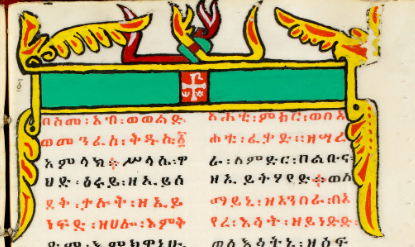
Quire numbers
Quire numbers appear in the upper margin of the recto page of every eleventh leaf, as each quire consists of five folded sheets. Scribes used Ethiopic numerals for quires that were derived from the Greek alphabet (in the same manner as in Coptic): ፩ (1), ፪ (2), ፫ (3), ፬ (4), ፭ (5), ፮ (6), ፯ (7), ፰ (8), ፱ (9), ፲ (10). The upper left part of Fig. 5 shows an example of such a quire number, number 1, which is based on a Greek alpha ፩ with two horizonal strokes above and below written in lighter, less noticeable ink. This marks the first quire of the book.
Indications for liturgical readings
The upper margins of some leaves may contain indicators that the text was intended to be used for monthly liturgical readings. This can be seen in Fig. 6, which reads ዘመስከረም za-maskaram, where the month Maskaram corresponds to September-October. One can interpret this indication as ‘the reading for September-October’.

The quire numbers and indications for monthly readings were both inserted by the same hand with the same writing utensil, probably a ball-point pen. It is difficult to say when these were added, for quire numbers are customarily marked when a text is copied, as an aid for when they are bound into a codex, while the indications for monthly readings can be marked either when the text is copied or later. Plausibly, by alternating the thickness of ink, the scribe wanted to differentiate between textual and paratextual levels.
Margins and paratextual elements
The outer margins are three times wider than the inner margins, and apart from the rare ‘guests’ just mentioned, the margins are empty. The outer margins in liturgical books were commonly wide enough to allow a page to be turned without touching the written area. From observation, one can deduce that Ethiopian scribes in general used rather simple layouts. Any glosses, comments or corrections would be entered in the margins, between the written lines, or wherever there was some extra space.
Use of the manuscript within the liturgy
Liturgical veneration of saints
The codex contains a collection of hagiographic texts, homilies, and stories about the life and deeds of Saint King Lālibalā, which together form a corpus of texts suitable for the liturgical veneration of the saint. Where and how his veneration began is unknown, but it was established by the fifteenth century, and the text is attested in codices from various monasteries or churches that were geographically remote from Roha-Lālibalā. While secondary sources imply that the liturgical cult of King Lālibalā had developed in Roha-Lālibalā by the sixteenth century, the earliest known material witness of his ‘Life’ preserved in the churches of Roha-Lālibalā dates to the end of the seventeenth or the beginning of the eighteenth century. Thereafter one can find traces of local liturgical commemoration that involved the regular performance of his ‘Life’ on 12 Sane (June-July) in accordance with traditions of the Ethiopian liturgical calendar, which includes monthly commemorations of Jesus, Mary, archangels, and saints along with annual celebrations (Fritsch 2001). Such commemorations vary from place to place, but typically involve liturgical readings from the commemorated saint’s ‘Life’ and ‘Miracles’. The month of Maskaram, mentioned above (Fig. 6, showing the reading for September-October),In total there are eleven indications for monthly readings, starting after the main celebration in June-July, when an entire text is supposed to be read at once. seems to demonstrate this for Lālibalā’s monthly celebration specifically, though it may have been common only in churches with a special devotion to Lālibalā, such as those having a tābot (a replica of the box with the tablets of the Mosaic Covenant, which can serve as a portable altar in the Ethiopian Church ; Leslau 1989) consecrated to him or some other form of devotion. Evidence for monthly readings is attested in some manuscripts starting from the fourteenth and fifteenth centuries, but in most cases they are later insertions that presumably reflect changing practices—dividing up a text for recitation at liturgy—although this was not applied rigorously. From what can be observed, and regardless of the presence or absence of indications for monthly readings, the book was read from the beginning to the end over a certain period of time according to the practice of lectio continua—continuous reading of Scripture and devotional literature common in Christian traditions.
Beyond indications for monthly readings, MS BP Parm. 3852 contains a series of navigational elements that stand out visually, and guide the reader through the text: abbreviations, blank spaces, recurrent formulas, short titles, and red ink. Such elements were apparently introduced to manuscripts of the Life of Lālibalā by the end of the seventeenth or beginning of the eighteenth century in the centre of manuscript production at Lasta.
The new pattern of textual segmentation of the Life of Lālibalā
By the fifteenth century, at the latest, Roha-Lālibalā had become an important centre of religious pilgrimage. Although it at first held little political importance, by the end of the seventeenth century (according to Getatchew Haile and Claire Bosc-Tiessé), Roha-Lālibalā and its surrounds had become a regional centre of power that was opposed to the king in Gondar. One of the best-known Lasta chiefs of that period was Qərlos/Gubālā (1698–1723), who was considered a rebel in Gondar, yet his was a time of relative peace and stability, which enabled local culture to flourish and a certain artistic style, now called the ‘school of Lasta’ (Bosc-Tiessé 2019), to develop. Numerous manuscripts were produced in this period that enriched the collections of church libraries, including three manuscripts containing the Life of Lālibalā which were produced and donated to three churches of the Roha-Lālibalā complex: the church of Maryām (MS EMML 6921), the church of Giyorgis (MS EMML 6964), and the church of Golgotā (MS EMML 6931).Accessible via the Ethiopian Manuscript and Microfilm Library, a microfilming project jointly supported by several libraries, among which are church libraries of Roha-Lālibalā. Most microfilms are housed at the National Archive and Library of Ethiopia in Addis Ababa, with some hosted by the Hill Museum and Manuscript Library (HMML) at Saint John’s University, Collegeville, Minnesota. All three are preserved in their respective churches, and until very recently were still in use. Analysis of their textual and paratextual elements shows that all three were models for MS BP Parm. 3852, demonstrated by navigational elements that were first introduced in MS EMML 6931.
Evolution of the manuscript’s mise en texte
Among manuscripts containing the Gadla Lālibalā collection, some give the impression of a continuous textual body that contains no visual signs that might allow a reader to detect the boundaries between texts or textual units. Others, like MS BP Parm. 3852, contain a number of visual signs that allow a reader to distinguish between the ‘Life of Lālibalā’ proper and its neighbouring textual units (units 1–6 and 8–16).
The principle of undifferentiated mise en texte changed at the end of the seventeenth century, after one of the scribes in Lasta introduced ‘titles’ to delimit seven textual units one from another, naming each of them a ‘miracle’. These ‘titles’ do not always match the content, as not all textual units necessarily record separate miracles, but they nevertheless facilitate reading. The text shown in Fig. 7, (MS DabṢey-001, fourteenth to fifteenth centuries, Dabra Ṣǝyon Abuna ʾAbrǝham, Tigrāy), for example shows a page containing two distinct yet undifferentiated textual units: there is nothing to suggest visually where the Life of Lālibalā proper ends and where what I call ‘Three men visit King Lālibalā’ begins. The corresponding section in Fig. 1, however, is delimited with a set of navigational elements: a short title, abbreviations, blank space, and alternating red and black ink.

The insertion of such ‘titles’ may have caused confusion among the clergy: when I asked them about the contents of the manuscripts during the fieldwork trips to the Lālibalā town in 2014 and 2017, some mentioned only the Life of Lālibalā, while others mentioned the Life and the Miracles of Lālibalā as separate pieces.
Layout of the page
The columns above the dotted line in Fig. 1 contain the end of the Life of Lālibalā proper (ff. 33vb–118vb). The separating dotted line spans both columns, interrupting the normal sequence of reading to the end of the left column and continuing at the top of the right. The dotted line thus interrupts the flow of the text as if the sections above and below it were separate pages. What appears below the dotted line on the left is a preamble to the text on the right, and contains the following formulaic phrases (here in English translation) that serve as navigational elements:
[Trinitarian formula:] In the name of the Father and the Son and the Holy Spirit, One holy God.
[Short title:] Miracle of King Gabra Masqal, the beloved one of Our Lord Jesus Christ.
[Supplication:] Let his prayer and blessing be with his beloved [space left for the name of the beneficiary] for ever and ever, amen.
The supplication contains a blank space where one would expect the name of a beneficiary—the person who commissioned the copy or the buyer. All of the Gadla Lālibalā collection manuscripts that date to before the twentieth century have this space filled, whether during copying or later, though in manuscripts from the twentieth century it is left empty. Arguably, the presence of empty spaces may reflect a new style, or be a sign of modernization adopted from printed books.
The text of ‘Three men visit King Lālibalā’ begins in the column to the right. Note that the text in both columns beneath the dotted line is written in alternating blocks of two red and two black lines. The black lines may also contain elements highlighted in red ink, such as the words ‘his miracle’ in the left-hand column and ‘Lālibalā’ in the right. Such elements are consistently highlighted with red ink throughout the text.
Conclusion
The earliest attested examples of ‘titles’ for some texts of the Gadla Lālibalā collection, sometimes referred to as the ‘Miracles of Gabra Masqal’, are in the manuscript known as MS EMML 6931. This dates to the late seventeenth or early eighteenth century and is preserved in the church of Golgotā, which is said to contain the tomb of King Lālibalā. Titles do not appear in the three manuscripts dating to the fourteenth or fifteenth centuries (one of which is presented in Fig. 7, MS DabṢey-001). Why were titles introduced in MS EMML 6931? Priests in Lālibalā churches have told me that this codex was taken out of the church of Golgotā on the twelfth day of each month to be read aloud as part of the commemoration of Saint King Lālibalā. The sequence was to first read the preamble, then a monthly reading from the Life of Lālibalā and one ‘Miracle’. Titles would have helped the priests to identify the beginning of each miracle and would therefore have had a functional purpose for the liturgical veneration of Saint Lālibalā.
MS EMML 6931 also contains the only known attestation of the antiphons (liturgical chants) for Saint Lālibalā. It was during the seventeenth century that a tābot for Saint Lālibalā was consecrated and placed in the church of Golgotā of Roha-Lālibalā, so one can plausibly associate three factors—the consecration of a tābot, the composition of the antiphons, and the commissioning of manuscripts with titles—with a liturgical function. All seem to be associated with the reign of King Qərlos and with the church of Golgotā. Plausibly, all three factors were part of a project aimed at strengthening local identity, one that chose Saint Lālibalā to be a regional patron.
This observation leads to questions regarding who might have commissioned MS BP Parm. 3852 during World War II, and for what purpose. At the end of the manuscript (Fig. 8) is a colophon: ‘This book was written in 1932 year of Mercy in the year of John in the month of Tāhsas in the fourth year of the reign of Emmanuel, king of Rome and Ethiopia’. The name Emmanuel is also mentioned in the first supplication in the text (Fig. 9): ‘Let the prayer and blessing of Saint Lālibalā protect his beloved [space left blank for the name of a beneficiary] and our king Emmanuel.’.
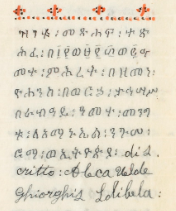
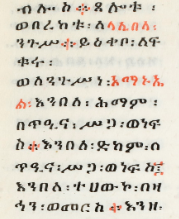
The date mentioned in Fig. 8, Tāhsas 1932 year of Mercy, corresponds to the year 1939/1940 of the Gregorian calendar—the fourth year after the Italian army, at the behest of a fascist regime, invaded Ethiopia and King Vittorio Emanuele III was proclaimed king of Ethiopia.
The colophon ends with a note in misspelled Italian, written in the Roman script: ‘di scritto’ (narrated).Discritto is a misspelling for descritto (told, related). The scribe’s knowledge of Italian was evidently less than perfect. As Ethiopic copyists do not commonly refer to themselves as 'narrators', the scribe must have looked for a verb meaning ‘copied’ and confused it with ‘descritto’. This is apparently followed by the scribe’s name: ‘Aleca Uolde Ghiorghis Lalibela’.‘Aleca’ stands for alaqā, ḥalaqā Amh./Təgrəñña አለቃ, ሐለቃ (chief, commander), originally a military rank that came to be an ecclesiastical title given to the head of a dabr; see Kidane (2003: 191–92). There is another note at the beginning of the codex written in the same hand (Fig. 10), which reads ‘Uolde Ghiorghis Tecle Micael Eritrea Segheneiti’, combining a personal name or names ‘Uolde Ghiorghis Tecle Micael’ and the toponyms ‘Eritrea Seghenait’.

Both the personal name(s) and toponyms seem to suggest that the hand that wrote the codex and the colophon, including the words in Italian, was that of Walda Giyorgis (Uolde Ghiorghis). Since the name of the scribe is written in both fidal and Roman, and the ink and the thickness of the strokes appear to be the same in both the main text and the colophon, it seems that this scribe was trained in both scripts.
Titles that facilitate the identification of specific parts of the liturgy were first used in MS EMML 6931, from Roha-Lālibalā, but it is unclear whether MS BP Parm. 3852 derives directly from that manuscript or had one or more antigraphs in between. The Italian part of the colophon does mention ‘Lālibalā’ (Fig. 8, bottom right corner), and seems to reference the scribe’s place of origin, but the slight gap between the name of the scribe and the word ‘Lālibalā’ leaves some doubt as to whether ‘Lālibalā’ should be taken as part of the scribe’s identity, and hence to his origin in Roha-Lālibalā. It might equally refer to the place where the copy was produced, to the origin of its antigraph, or simply be a keyword for the Life of Lālibalā.
‘Segheneiti’ (or Saganayti), visible in Fig. 10, is a town in Eritrea that saw the presence of many Catholic missionaries in the nineteenth century, at which time the Catholic Church in Ethiopia-Eritrea was represented by two Rites—the Catholic Church of the Roman Rite and the Catholic Church of the Ethiopian Rite. King Lālibalā was regarded as a usurper by the so-called Solomonic dynasty, and Emperor Haile Sellasie I claimed to belong to this dynasty and even wrote its privileged role into the Constitution of 1931. Chapter I, ‘The Ethiopian Empire and the succession to the throne’, paragraph 3, reads:
It is provided by law that the Imperial Rank shall remain perpetually in the line of His Majesty Haile Selassie I, descendant of King Sahle Selassie, whose lineage continues unbroken from the dynasty of Menelik I, son of King Solomon of Jerusalem and of the Queen of Ethiopia, sometimes called the Queen of Sheba.
From this perspective, King Lālibalā in the twelfth century and King Vittorio Emanuele III in 1936 both violated the Constitution of 1931; but this was definitely not the view held by Walda Giyorgis, who copied the Life of Lālibalā and asked for the saint’s intercession to protect the reign of Emanuele III. 1939/1940, the year when the manuscript was copied, was the fortieth anniversary of Emanuele III’s accession, and only shortly before British forces entered Eritrea from Anglo-Egyptian Sudan in January 1941. Given the mention of Saganayti, of loyalty to the ‘King of Rome’, and the chi-rho staurogram on the first decorated page, it is not too much of a stretch to imagine that Walda Giyorgis was a Catholic Eritrean who knew both Roman and Geez scripts. Considering that the codex is laid out for liturgical service, it seems the scribe was familiar with the Ethiopic liturgy, which suggests that he belonged to the Catholic Church of the Ethiopian Rite.
Saint Lālibalā’s intercession in the Heavenly Kingdom was sought on behalf of the local regional opposition to Gondar at the end of the seventeenth century, and then again on behalf of ‘pro-Rome’ Christians in the middle of the twentieth century. MS BP Parm. 3852 may have been produced in the twentieth century, but it conformed to much older models, which suggests the continuation of Lālibalā’s monthly commemoration by Catholics in Saganayti who would also pray for Emanuele III’s enduring reign. Given that the manuscript was completed shortly before the British invasion of 1941, it is perhaps unsurprising that the codex does not seem to have been employed at liturgy: there are no traces of wax, soot, or anything that would indicate that the manuscript has ever seen use. This implies that the manuscript soon left Eritrea, either as a gift to Emanuele III or to be part of a connoisseur’s collection.
